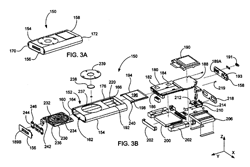Patent application reveals much about iPod/iPhone


Keep in mind that Apple (and most tech companies) keep their patent applications intentionally vague. Techniques include being overly verbose ("in one particular embodiment") and using drawings that look like they were drawn by a four year old. Apple knows that these patent applications will be found and published and they do everything they can to keep them vague to throw off the press and competitors. Which is understandable.
Seamless enclosure
Patent application #20060268528 is mostly about the iPod enclosure and it goes to great lengths to describe how it manufactured to be "a seamless enclosure that includes open ends for inserting the internal components. "This "extruded tube" design eliminates "undesirable cracks, seams, gaps or breaks at the mating surfaces and fasteners."
The "open ends for inserting the internal components" gives the impression that said iPod could be screen and/or memory upgradeable or even feature a removable battery, but I wouldn't bank on it. Apple makes far too much money from people flipping their iPods when a new model comes out, but it's perfectly logical that the iPhone would feature a removable battery (or two.)
Apple is clearly laying claim to the clean, one-piece iPod enclosure seen in the aluminum (second generation) iPod nano and the original iPod mini. If granted, this patent could effectively relegate competitors to using the sandwich-like design of upper and lower casings that is "time consuming and cumbersome" to assemble.
iPod on rails
The other key component of the patent application are the seamless enclosure's internal rails "which serve as a guide for positioning and supporting the internal components in their assembled position." This is nothing new as the 2g iPod nano and mini both had internal rails. Internal rails are also frequently used in aluminum mobile hard drive enclosures.
Radio transparency
This is where the patent gets interesting. Since this patent covers a "portable computing device" (tablet?), a "handheld computing device" (PDA?), and/or a "portable computing device capable of wireless communications" (mobile phone) Apple decided to switch materials.
According to the patent several factors affect material selection, including: tensile strength, density, strength to weight ratio, Young's modulus (a measure of the stiffness) corrosion resistance, formability, finishing, recyclability, tooling costs, design flexibility, manufacturing costs, manufacturing throughput, reproducibility, electrical conductivity, thermal conductivity, radio wave transparency, combustibility, toxicity, and aesthetics (color, surface finish, weight, etc.)
While Apple currently manufactures extruded tubes from aluminum because of its light weight, structural strength and reduced tooling costs, the patent also covers enclosure's extruded from "ceramics such as zirconia or alumina" for radio transparency.
Some of the reasons for using ceramics over other materials is that it is structurally strong, stiff and radio transparent. This is especially important for wireless hand held devices that include antennas internal to the enclosure. Radio transparency allows the wireless signals to pass through the enclosure and in some cases enhances these transmissions. Other reasons for using ceramics is that they are highly scratch resistant, have color embedded in it (no paint or coatings), can be made into a wide variety of colors, and provides a variety of surface finishes including smooth and rough. Furthermore, the density of ceramics is typically higher than other materials therefore their weight is higher for the same sized part. This additional weight makes the handheld device feel more robust and it makes the device exude greater quality.
If this patent has a smoking gun, the above paragraph is clearly it. To date iPods haven't included radio transmitters, but Apple is clearly investigating the new ceramic enclosure design because it allows radio waves to easily pass through the enclosure. The company has clearly learned a less from the abysmal WiFi performance in the Titanium PowerBooks and it wouldn't surprise me if ceramic composite MacBooks were in our future.
Although not shown, the internal components may also include components for processing, transmitting and/or receiving wireless signals (e.g., transmitter, receiver, antenna, etc.). By way of example, the device may include components for supporting FM, RF, Bluetooth, 802.11, etc.
That's a hell of a feature set. Can you imagine an iPhone with GSM, FM, Bluetooth and WiFi built-in? I can't because it would kill your battery in less than an hour. But that's the point, Apple's merely covering its bases by patenting a "radio transparent" enclosure so that will support an internal radio - mostly for the iPhone. They can use the new enclosure design as a stepping stone to WiFi and Bluetooth.
If granted, Apple gains two key things with this patent: the extruded tube design and the use of "radio transparent" materials such as ceramic in the enclosure. Any manufacturer wishing to use these items in their mobile phone or media player design would have to license the technology from Apple or face the wrath of Apple legal.
Tomorrow I'll discuss some of the other interesting aspects of United States Patent Application #20060268528, including multiple input devices, dedicated power button and power ports and new battery technologies.
The usual patent disclaimers apply: Apple may never use any of the items in this patent or they may incorporate all of the into some sort of frankenphone. They're using the patent to protect as much technology and balancing that with giving as few hints as possible to the media and competitors.